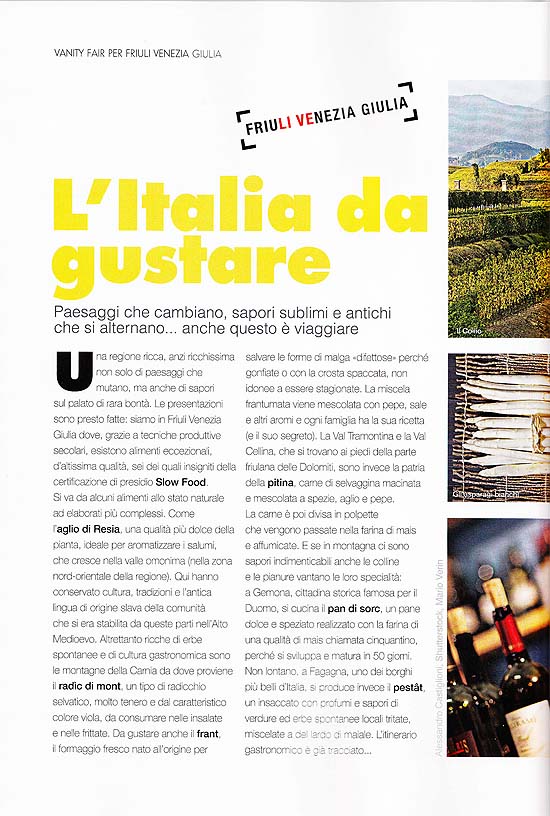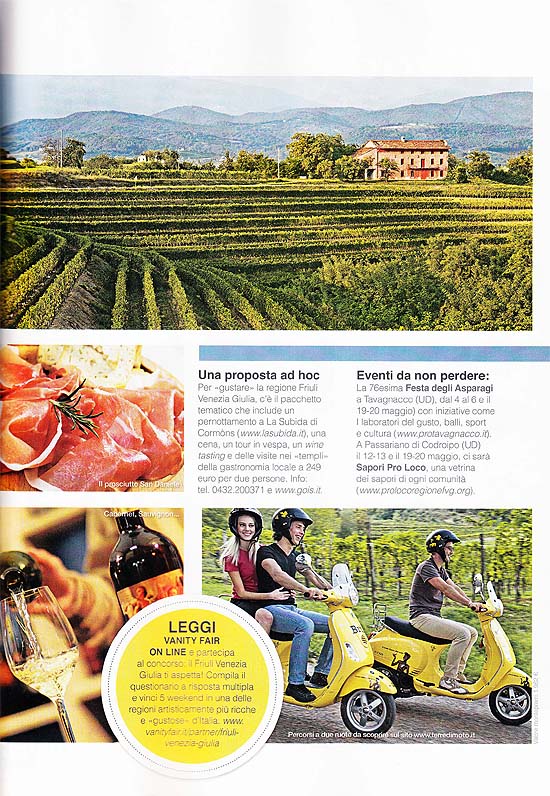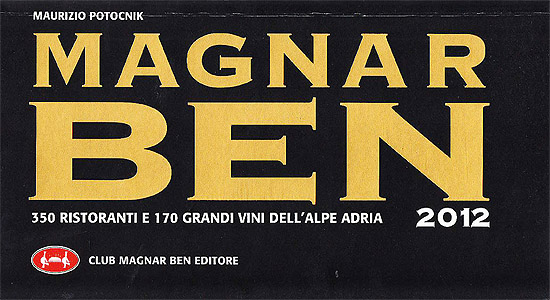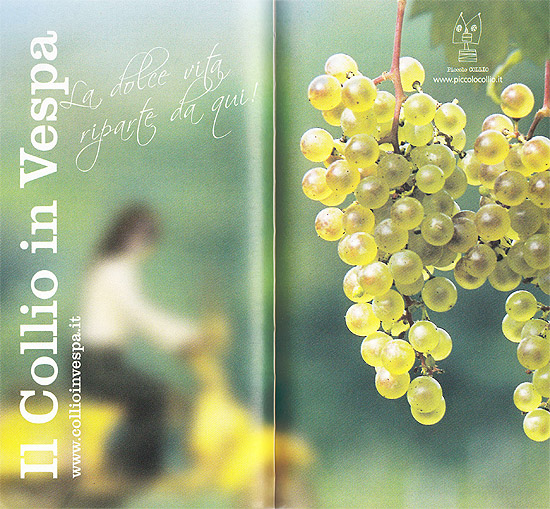|
|
22 aprile, 2012 Con il patrocinio dell Ufficio Turistico FVG è uscito su Vanity Fair n.15 del 18 Aprile 2012 un bell’articolo nel quale trovano bella vista le nostre Vespe.
All’agenzia e al giornalista il nostro grazie e per tutti noi l’orgoglio per l’immagine vincente della nostra terra da godersi in vespa.


Share on Facebook
19 aprile, 2012 Anche quest’anno la guida MAGNAR BEN ha inserito la nostra offerta di Collio in Vespa nella sua edizione.
Maurizio Potocnik si è ancora una volta dimostrato amico del Collio e per questo o per altro il nostro grazie.


Share on Facebook
11 ottobre, 2011
July 2, 2011: Three weeks after this post appeared, the New York Times runs big interactive feature by Ingrid Williams about, yes, riding a Vespa along the Collio trail.
I admit it, I’m a sucker for scooters. I drive the Yamaha Vino in Seattle, so I jumped at the chance to tour the Collio hills on a sunny Sunday afternoon on a bright yellow Vespa.
And what a sweet machine it is. Room under the seat for Michael’s D80 loaner with its 12mm lens. Off I go, into the hills, toward San Florian (church square under reconstruction), down again to Oslavia (World War One ossuary, remains of 60,000 soldiers), stop on market square in Cormons for Aperol spritz and bowl of gulasch soup.
More photos online:
Scooter outing courtesy of the elegant resort Castello di Spessa. This trip to Italy is being hosted by the Cosorzio Collio Carso, whose motto, I need not remind you, is I Love Collio!
Dal sito paninopanini.blogspot.com, scritto da Ronald Holden
Share on Facebook
7 settembre, 2011 Turismo FVG e il consorzio Grado Turismo hanno ritenuto di inserire nei loro spot per l’annata turistica 2012 le Vespe del Collio.
Le riprese in pompa magna con troup e modelle sono state fatte tra i vigneti di Russiz, sul Monte Quarin e all’azienda Borgo San Daniele in Cormons.


Share on Facebook
5 settembre, 2011 Nonostante la pioggia, siamo riusciti a completare la nostra sfilata per le vie di Cormons.. è veramente bello vedere tante Vespe Collio insieme!
Con l’augurio di riuscire a riunirci più spesso..
Grazie a tutti i partecipanti!!



Share on Facebook
17 agosto, 2011 
Anche l’azienda Venica&Venica si presenta con la Vespa gialla del Collio
Complimenti!
Share on Facebook
18 luglio, 2011 

Da Primorski Dnevnik, 4.luglio.2011
Share on Facebook
4 luglio, 2011 In Italy, Vineyards by Vespa

Dave Yoder for The New York Times
The author on the Vespa she rode through the Collio wine district of northeastern Italy, where she tasted some of the region’s best whites along the way.
By INGRID K. WILLIAMS
“IS it normal for the carabinieri to be drinking at noon?” I asked, gesturing toward five members of the Italian military police swirling and sipping glasses of white wine.
Dave Yoder for The New York Times
“No,” said the bespectacled, curly-haired man standing next to me at the Enoteca di Cormòns, with a chuckle. “But it’s Friulano,” he said, referring to the local varietal, “so it’s O.K.” A sly smile widened beneath his gray mustache as he clinked his glass against mine.
My husband, Dave, and I had just arrived in Collio, a sleepy wine region in northeastern Italy defined by crisp white wines that are among the country’s best. Hugging the border with Slovenia, Collio has a curious culture that leans more Mitteleuropa than Mediterranean, but the ideal way to taste the terroir-rich whites produced in these bucolic hills is still unmistakably Italian: cruising between rural vineyards on the iconic vehicle of Italian daydreams, the Vespa.
Marrying wine tastings with Vespas may seem foolhardy at first. However, with a few sensible precautions (alternating driving duties with a companion, taking leisurely vineyard tours after each tasting, spitting), it’s an unexpectedly fun union that captures the same carefree spirit that Dave and I first encountered at the enoteca, without veering into irresponsibility.
The seed of Collio’s vino-and-Vespa idea can be traced to one historic night in late 2007 and two friends, Edi Keber, a vintner, and Josko Sirk, a vinegar producer and owner of La Subida, an area inn with a Michelin-starred restaurant. “On the day when the border was removed and Slovenia officially entered the E.U., Edi and I took two Vespas,” Mr. Sirk told me, recounting the story of the joyful celebration. “All night long, we drove back and forth across the border.”
That jubilation has since blossomed into the “Collio in Vespa” program, in which about 70 Vespas, all painted a sunny hue, are now available for tourists who want to zip between tours and tastings.
So for four days in May, Dave and I did just that, landing a clutch of new friends along the way.
1. Ready, Set…
We planned to spend our first two nights at La Subida, a hotel in the hills, where, with the exchange of a key, we became the proud new custodians of one canary yellow 125-cubic-centimeter Vespa made for two. Since I had more experience driving a Vespa (four days to Dave’s one), I hopped in front first. But riding a Vespa is not like riding a bike; you can forget how.
To the evident amusement of a man sitting on a nearby bench, it took me an embarrassingly long time to recall how to start the engine (oh, right, apply the brake), and once started, how to accelerate (rotate the handlebar backward, not forward!). But then we were off, swerving onto the road and into a frolicking, unforgettable adventure that neither of us saw coming.
2. Enoteca di Cormòns: Ugo and His Many Friends
Our first stop was the Enoteca di Cormòns on the main piazza in the town of Cormòns, the very heart of Collio.
Cormòns is the sort of small, tight-knit place where describing someone as “Ugo with the glasses” is met with nodding recognition. The Ugo in question was our bespectacled new friend (and the local optician), who, after the carabinieri had departed, quickly introduced us to his friends, each of whom was a full generation older than we were. I have lived in Italy for nearly four years, but never before have I been so warmly embraced by strangers.
Within 20 minutes, though Dave and I were still nursing our first glasses of crisp Friulano, Ugo had bought us another round, and his friend Giovanni had escorted us outside to meet a visiting member of the Italian Parliament. Before we had even finished our platter of local Montasio cheese and hand-sliced prosciutto, Giovanni was inviting us to a private party later that night.
Literally marking an “X” at the location on our map, he told us, “Just say you’re friends of Giovanni’s.” Because, of course, we now were.
3. Edi Keber Winery: Hurdle in the Hills
The genius of touring Collio by Vespa is that there are dozens of vineyards scattered through the hills and not much traffic. Most wineries are family-run, and with a little notice, open to the public. Even in high season, tractors are more common than tour buses, and visitors can pop into almost any vineyard and taste rare vintages with the vintners themselves.
With Dave driving, we zoomed out of Cormòns along peaceful pastoral roads and up and over vine-draped hills. We had booked a tour and tasting at Edi Keber, a small winery known for producing mineral-rich white wine from a blend of Collio-grown Friulano, malvasia istriana and ribolla gialla varieties. As we neared our destination, a verdant patchwork of vineyards unfolded across the valley like a quilt; Slovenia’s stone farmhouses were just a grape’s throw away.
But then: near disaster. Turning the Vespa — perhaps a hair too fast — into the driveway, we skidded on the loose gravel and toppled to the ground, the scooter pinning my leg under the still-running and gravel-spewing machine. We clawed our way out from under the scooter, and once upright again, surveyed the damage: bruising to Dave’s pride, a scratched windshield on the Vespa and, for me, a greenish-purple right calf.
Composing ourselves, we joined Mr. Keber’s charming son Kristian in a restorative wine tasting. Since 2008, the winery has produced only one wine each year: a crisp, subtly floral white that is called, simply, “Collio.”
4. Outside Cormòns: Marino’s House
Having recovered from our afternoon scare, we made our way to the party heading up a driveway toward a grill billowing smoke, unsure we were at the right place. We arrived in an open, brightly lighted garage, where nearly two dozen people were gathered around a long table strewn with bottles of wine. Scanning the crowd in search of a familiar face, I had the sinking sensation that we were crashing a stranger’s dinner party when — there! — I spotted Giovanni.
A swirl of introductions ensued, and we were quickly plied with dripping skewers of goat meat pulled right off the grill. Soon the host of the party bounded over. Jovial and stout, with a bushy snow-white beard, Marino was Santa in the flesh.
“Come, sit, eat, drink!”
Creedence Clearwater Revival blared from speakers as we were shepherded to the table. There, the procession of food began: more meat skewers, bread, ostrich-egg frittata, homemade apple strudel.
Someone poured some Magnás sauvignon in my glass. “You know Magnás?” the pourer asked. When I shook my head no, I was presented to the vintner, Luciano Visintin, who gave me a wink from across the table.
It was inching toward midnight when the crowd began to thin. But by then, Carmelo, an animated Sicilian in head-to-toe denim and a thick, gray mustache, had already concocted more plans. “In Collio, mangiare, bere e basta,” he said: eat, drink and that’s it. So the next day at noon, the party would continue.
5. Magnás: Resuming the Feast
A screwball cast of nine rolled out of the enoteca the following day at lunchtime — among them, Carmelo, Marino, Giovanni, along with a retired Italian Air Force general and a white-haired man referred to simply as Il Presidente.
The local Collio cuisine has heavy Slavic and Austro-Hungarian influences, so meats and potato dumplings are more common than pasta and pizza, as we learned during our first stop, a rustic trattoria run by a local butcher, Sandro Seculin. Wine, then grappa, flowed freely around the table before the motley platoon retreated to Luciano’s winery, minutes down the road.
Once there, Marino insisted on giving me a tour of the property, showing off the stainless steel vats, the chicken coop and the pen with newborn bunnies. When we rejoined the group lounging on a terrace, Luciano was preparing an impromptu tasting. Vintners here grow many varieties and employ a wide range of techniques in the winemaking process, but the resulting wines are often surprisingly similar, with differences measured in subtle gradations of floral notes and hints of fruit.
When we eventually had to bid our new friends farewell — another tour, at the Dario Raccaro vineyard, awaited — we were rebuffed. “We’ll see you later,” Marino insisted knowingly, brushing my cheeks with his beard as he kissed me goodbye.
6. Castello di Spessa: Out of Gas
After two nights at La Subida, we decamped for our final two nights to Castello di Spessa, a creaky, apricot-colored castle at the end of a trellised path. It resides above a rolling 18-hole golf course framed by vineyards.
Winding along Collio’s tranquil back roads, I glanced at the gas gauge to see a fierce orange light blinking with great urgency, likely a Morse code for “Get thee to a gas station!”
Finding ourselves surrounded by indistinguishable rows of vines, Dave consulted the map, the sun, then the map again. Where were the gas stations hiding? Meanwhile, the menacing light seemed to blink more brightly around each bend. The engine hesitated when we merged onto a main road, but our beacon — an IP gas station sign — soon appeared. As the pumps finally came into view, the engine sputtered, and I heard Dave shout, “Lean forward!”
7. Gravner: Jug Wine
There’s no sign outside the Gravner winery, just a gravel driveway littered with giant terra-cotta jars, or amphorae.
“Amphora for wine is like amplification for music,” said Josko Gravner, the lanky vintner who, with his devoted dog Bruno trailing at his heels, had led us down into a dimly lighted cellar to show us his unconventional winemaking process, in which fermentation occurs over several months in amphorae buried to their top rims.
As he held a glass of sauvignon up to a light, the white wine appeared cloudy and undeniably orange. “You have to drink it to understand it,” he said. So I did.
8. Gorizia: Taking a Break From the Wine Trail
To assuage the guilt of doing little more than riding around on a Vespa and tasting wine for four days, we decided to visit the Oslavia military memorial, commemorating soldiers killed in World War I, and from there make our way to the town of Gorizia and its castle. The memorial was stark and moving, and the turquoise Isonzo River that cuts through Gorizia is lovely, but the castle, except for a few creepy faceless mannequins, was a bore. There was, however, a memorable lunch at Alla Luna, a restaurant cluttered with doilies, lace, dried flowers, keys and overstuffed pillows. We ordered fried potato-and-cheese crisps called frico; “Mitteleuropa gnocchi” drowning in butter, sugar and cinnamon; and “Slovenian gnocchetti” in a brown, meaty gravy that the menu described as “not nice to look at, but delicious to eat.”
My palate had not yet adapted to the heavy local cuisine, so we skipped dessert and bolted back across the river and into the quiet hills of Collio.
9. Venica & Venica: Different Concepts, One Idea
Following a tasting at Venica & Venica, we ran into Giampaolo Venica, the vineyard’s export manager, who, though still dressed in bicycle gear after a long ride, immediately offered to give us a tour. From a nearby hilltop, he pointed out the various plots of the vineyard, which was started by his grandfather and is now run by his father, Gianni, and uncle, Giorgio. “Collio is funny,” he said. “It’s one idea, but completely different ways to achieve it.”
It was true. We had visited Kristian Keber, who believes in making just a single kind of wine (“to promote the area and not a variety”); Venica & Venica, which produces 13 different varietals; Josko Gravner, who uses amphorae; and Raccaro, another small producer, where the wine passes through stainless steel vats.
Different beliefs and different methods, but award-winning results for all; in 2010, wines produced by each of those four vineyards earned the highest “tre bicchieri” rating from Gambero Rosso, the premier food and wine magazine in Italy. (In total, 15 Collio-designated whites earned the top rating last year.)
10. Back to Cormòns: Goodbye
For our last evening in Collio, Dave and I returned to Cormòns. Between a wine-tasting event at the enoteca and dinner at Al Giardinetto — the one restaurant that was recommended by everyone we asked — we took a short stroll through town. Around the corner from the main piazza, a familiar face popped out of a doorway: Ugo, the catalyst for our entire adventure. And when Dave and I circled back to the enoteca for a final glass of wine after dinner, we got a full-fledged reunion.
Kristian Keber was sitting outside with a group of friends. From inside, Elena the manager waved. Kristian soon followed us in, slipping behind the bar for glasses and insisting that we taste the bottle he had just bought for his friends. Back out on the piazza, one of the men from Marino’s surreal party stopped by our table to say hello, and before long, Marino himself appeared. Enveloping us in bear-paw handshakes and bushy-beard kisses, he finally bade us farewell. And with a rosy-cheeked smile, he bounded off into the Collio twilight.
If You Plan to Visit Collio, and Its Paths and Vineyards
In Collio, many inns, hotels and wineries have Vespas that guests may use for no additional charge. Vespas can also be rented in Cormòns at Azienda Zorgniotti (Via Vino della Pace, 18; 39-0481-60595) for 50 euros, or about $70 at $1.42 to the euro, a day.
WHERE TO STAY
La Subida (Via Subida, 52, Cormòns; 39-0481-60531; lasubida.it) is a complex of country cottages with a pool, playground and outdoor foosball table. The Michelin-starred restaurant Trattoria Al Cacciatore della Subida is a short walk away. High-season rates start at 110 euros a night.
Castello di Spessa (Via Spessa, 1, Capriva del Friuli; 39-0481-808124; castellodispessa.it) is a grand hotel in a castle that dates back to the 13th century, with rambling grounds, an 18-hole golf course and an elegant restaurant. Doubles cost 180 euros a night.
Many of the wineries we visited also offer guest rooms to visitors who prefer to sleep close to the vines. One that also has Vespas is Edi Keber, where rooms cost 90 euros a night.
WHERE TO TASTE
At Collio’s small family vineyards, it’s wise to call in advance to arrange tastings. Edi Keber (Località Zegla, 17, Cormòns; 39-0481-61184). Magnás (Via Corona, 47, Cormòns; 39-0481-60991; magnas.it). Gravner (Località Lenzuolo Bianco, 9, Oslavia; 39-0481-30882; gravner.it).Venica & Venica (Località Cerò, 8, Dolegna del Collio; 39-0481-61264; venica.it). Dario Raccaro (Via San Giovanni, 87, Cormòns; 39-0481-61425) is a small winery with a big reputation: three years ago (2008), their 2006 Tocai Friulano was named the best white wine in Italy by Gambero Rosso, the country’s premier food and wine magazine.
WHERE TO EAT
Enoteca di Cormòns (Piazza XXIV Maggio, 21, Cormòns; 39-0481-630371; enoteca-cormons.it). Agriturismo Seculin (Località Monticello, 2, Cormòns; 39-334-345-5285; aziendaagricolaseculin.com). Alla Luna (Via Guglielmo Oberdan, 13, Gorizia; 39-0481-530374). Al Giardinetto (Via Giacomo Matteotti, 54, Cormòns; 39-0481-60257). D’Osvaldo (Via Dante, 40, Cormòns; 39-0481-61644; dosvaldo.it) is a local producer of artisanal meats famed for its smoked prosciutto, a Cormòns specialty. Call ahead for a tour and tasting.
Dal sito di NEW YORK TIMES – Travel
Share on Facebook
28 giugno, 2011 È veramente bello vedere Piccolo Collio in città!
La simpatia che il signor Bernot ha voluto riservare a Collio in Vespa e a Piccolo Collio, e il conseguente allestimento del negozio in Corso Verdi a Gorizia sono una cosa che ci lusinga.



Share on Facebook
|